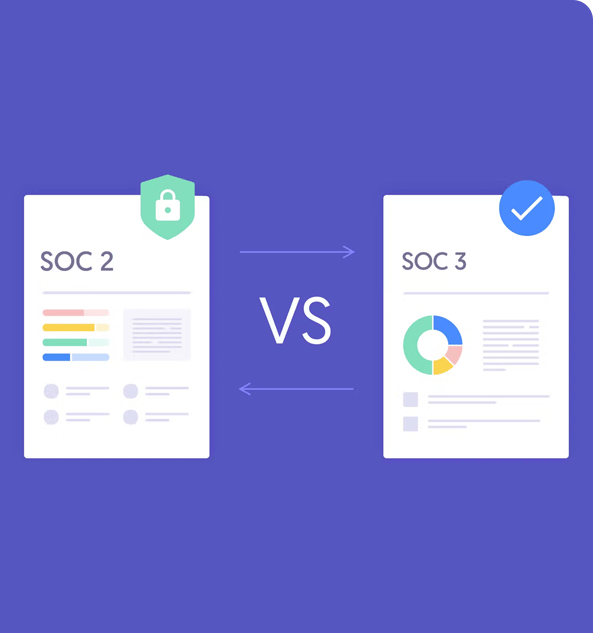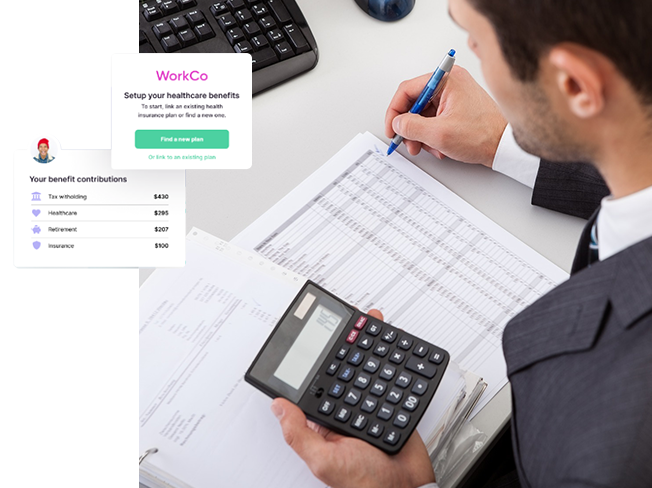
Compliance is critical to your business’s growth.
As a startup, you might not expect to deal with compliance. But as your business flourishes, you might have to handle many different roles, and one of the key ones is compliance, even if it doesn’t seem to fit well.
SOC, which stands for Service Organization Control, is about showing that your company has reasonable controls in place. This is important because accountants look for it when considering your company SOC-compliant.
Being SOC-compliant matters a lot. Without it, your startup might miss out on big deals with large companies, which are crucial for keeping your business going.
In this blog, we will explain SOC 1, SOC 2, and SOC 3 – We will cover what each one means and how they differ. By the end, you’ll know which SOC report is most relevant for your startup and what you need to do to become compliant.
Understanding Terminologies
Understanding these terminologies is crucial. Don’t hesitate to scroll back up and consult this key as you read.
- SOC: Service Organization Control.
- SOC Report: A document with internal controls. It aims to help customers assess the risks of using an outsourced service.
- AICPA: The American Institute of Certified Public Accountants (organization that standardizes SOC compliance).
- CPA: Certified Public Accountants (licensed and registered accountants, issuing SOC 1, 2, and 3 reports).
- Control: A policy designed to achieve a desired outcome or prevent an undesirable one.
- Service Organization: A firm providing information system services to other businesses, encompassing data centers, IT managed services, SaaS vendors, and similar offerings, which includes your company.
- Auditor: A designated representative from the user entity responsible for reviewing the SOC report(s).
- SAS 70: This acronym refers to Statement on Auditing Standards, of which numerous releases have occurred. Before SAS 70, there were minimal issues, but the 70th release led to confusion. In response, the AICPA issued SSAE No. 16 to provide clarification.
- SSAE No. 16 and SSAE No. 18: The acronym stands for Statement on Standards for Attestation Engagements, and we will not be using either term in this blog (breathe a sigh of relief). Suffice it to say SSAE No. 18 is what houses SOC 1, SOC 2, and SOC 3 (and it replaced the earlier house, SSAE no. 16).
Worried About Tax Season?
Say goodbye to stress and let us manage your
numbers with meticulous care.
SOC Reporting – A Short History
The reporting for SOC (Service Organization Control) has changed significantly. These reports give people confidence in a service organization’s rules, especially those dealing with customer data. The past SOC reporting shows how business has changed over time and how people’s needs for security and openness have grown.
Service groups used SAS 70 (Statement on Auditing Standards No. 70) before SOC reports came along. SAS 70, which came out in 1992, was made for finance reporting. But SAS 70 was often used in a wrong way. This meant it was not being used for what it was meant for.
The American Institute of Certified Public Accountants (AICPA) created the SOC framework in 2011 because they knew SAS 70 had problems and needed a more complete set of report rules. This was a significant change from just reporting on finances to focusing on internal controls and data security in a broader way.
SOC Types and Differences – A Brief Insight
| SOC 1 | SOC 2 | SOC 3 | |
| Primary Aim | To examine internal controls relevant to financial reporting. | To evaluate internal controls over five key areas: security, confidentiality, processing integrity, privacy, and availability. | To convey the essence of SOC 2 compliance in simpler terms for the general public. |
| Scope of Control | Manages the processing and protection of financial data for customers. | Oversees controls across the five foundational principles of Trust Services. | Maintains oversight on the same Trust Services Principles as SOC 2. |
| Example | An entity like an insurance claims processor that manages financial data necessitates SOC 1 adherence. | A data hosting provider ensures that data handling meets stringent standards for security and privacy, aligning with SOC 2 guidelines. | A large corporation may issue a SOC 3 report to affirm its commitment to secure data handling and privacy protection publicly. |
| Recipients | Geared towards auditors and others who need detailed insight into financial control effectiveness. | Targeted towards customers and stakeholders vested in security and control measures. | Geared towards the broader audience without the need for detailed internal knowledge. |
| Benefits | Affirms the presence of robust financial control mechanisms, bolstering confidence among clients requiring financial integrity. | Assures comprehensive data protection controls, enhancing trust with stakeholders requiring detailed information. | Serves as a public declaration of data protection standards, reinforcing the company’s reputation for protecting client data |
SOC Reports – Digging into the Details
Service Organization Control (SOC) reports give you a deep look into the systems and processes of a service organization. They are the best way for auditors to look closely at companies’ internal control measures to keep data safe and ensure their operations are honest.
Tailored Solutions to
Your Business
Needs
We believe that each business is unique, which is
why we tailor our bookkeeping services to meet your
specific needs. From companies to established businesses,
we have your back!
Contact-Us
What is an SOC 1 Report?
An SOC 1 report is prepared under the SSAE 18 standard (Statement on Standards for Attestation Engagements). It specifically evaluates the internal controls of a service organization that may impact a client’s financial reporting. Essentially, it’s an audit of the transactional processes and controls that could affect the integrity of the financial statements of the service organization’s customers.
What does SOC 1 Compliance Do?
SOC 1 compliance demonstrates that a service organization has undergone a thorough audit of its control activities—including those related to information technology and related processes. This compliance assures clients that the organization adheres to high financial reporting and control standards. It’s a sign that the company takes its role in the financial reporting chain seriously, ensuring its processes are designed and operating effectively to safeguard client data.
Types of SOC 1 Compliance
There are two types of SOC 1 reports:
- Type I: This report assesses the suitability of the design of controls at a specific point in time.
- Type II: This report further evaluates the operational effectiveness of these controls over a specified period, usually at least six months.
Type I and Type II compliance depend on the service organization’s and its clients’ needs, with Type II providing a more rigorous assessment.
When to Get SOC 1 Compliance?
Service organizations should consider obtaining an SOC 1 report when they handle financial transactions or information that could influence their clients’ financial reporting. This is especially relevant for service providers like payroll processors, data centers, or cloud software companies that process significant financial transactions on behalf of their clients.
Getting SOC 1 compliance is also a strategic move for service organizations looking to differentiate themselves in the market, build trust with clients, and establish a reputation for robust internal controls and financial integrity.
What is a SOC 2 Report?
An SOC 2 report evaluates a service organization’s information systems relevant to security, availability, processing integrity, confidentiality, or privacy. Created by the American Institute of CPAs (AICPA), these reports follow the Trust Services Criteria. An SOC 2 report is more about the systems services used to process data and the confidentiality and privacy of the information these systems process.
What does SOC 2 Compliance Do?
SOC 2 compliance assures that a service organization manages data in a way that safeguards the interests and privacy of its clients. It is a comprehensive certification that examines a company’s non-financial reporting controls related to IT and data security. It assures clients that a service organization has implemented and follows strict information security policies and procedures.
Lighten Your Load with
Affordable BookKeeping
Packages
We offer competitive packages that won’t break the bank,
and up-front pricing so you know exactly what you’re getting
as your return on investment.

Types of SOC 2 Compliance
There are two types of SOC 2 reports:
- Type I: This type examines the suitability of the design and implementation of controls at a specific moment.
- Type II: This type goes further, assessing the operational effectiveness of the controls over a defined period, typically at least six months.
Type I provides a snapshot of the organization’s control landscape, while Type II provides a historical overview of how well those controls function over time.
When to Get SOC 2 Compliance
A service organization should seek SOC 2 compliance when it manages or hosts customer data that demands confidentiality and privacy. This is particularly relevant for SaaS providers, cloud computing services, and businesses that store customer data in the cloud. SOC 2 is essential for organizations that want to prove their commitment to security best practices and attract discerning clients who value data protection.
SOC 2 compliance is not just about meeting an industry standard but about embodying trust and security in a digital world where data breaches are costly. It’s a proactive step that shows an organization’s dedication to robust security measures and operational excellence.
What is a SOC 3 Report?
A SOC 3 report is a general-use report that summarizes the findings of a SOC 2 report. It’s designed to be easily digestible by a broad audience without revealing the sensitive and detailed controls and systems at a service organization. The report still adheres to the Trust Services Criteria—security, availability, processing integrity, confidentiality, and privacy—but presents the information in a less technical format.
What does SOC 3 Compliance Do?
SOC 3 compliance is a seal of approval for the general public, indicating that an organization maintains the required control over its systems to process users’ data. It reassures current and potential customers that their information is being handled responsibly and in line with recognized standards without sharing how they are met.
Types of SOC 3 Compliance
Unlike SOC 1 and SOC 2 reports, only one type of SOC 3 report exists. There is no distinction between controls’ design and operational effectiveness; instead, SOC 3 provides a simplified attestation of compliance with the Trust Services Criteria.
When to Get SOC 3 Compliance?
Organizations opt for SOC 3 compliance when they need to publicly demonstrate their commitment to data security and privacy but wish to do so without disclosing the specifics of their controls. It’s ideal for companies that want to market their compliance with recognized standards to a wider audience, such as potential customers, partners, or stakeholders.
SOC 3 reports are often used on websites and in marketing materials as a trust signal to the public, showcasing that an organization has completed a thorough audit of its controls and is committed to maintaining high data security and privacy standards.
Benefits of SOC Compliance
SOC reports are crucial in enhancing an organization’s trust, compliance, and operational excellence. Here are some of the benefits that you can attain from it:
- Enhanced Trust and Credibility: Demonstrates to clients and stakeholders that the organization is committed to high control and security standards.
- Competitive Advantage: Differentiates the organization in the marketplace, which is particularly important for service providers handling sensitive data.
- Improved Risk Management: Helps identify and mitigate risks related to data security, privacy, and operational processes.
- Regulatory Compliance: Assists in meeting various compliance requirements, which can be crucial for attracting and retaining clients, especially in regulated industries.
- Operational Efficiency: Encourages establishing and maintaining more efficient and secure operational processes.
- Client Assurance: Provides clients with peace of mind regarding the handling and protecting of their data.
- Market Access: Opens up opportunities to work with larger corporations and clients who require SOC compliance as a prerequisite for doing business.
- Increased Transparency: Offers a clear view of the organization’s control environment to stakeholders, enhancing transparency.
- Proactive Problem Identification: Facilitates early detection and resolution of potential issues in control and data management processes.
Standardized Reporting: Provides a standardized framework for reporting on controls and processes, making communicating with stakeholders familiar with SOC reports more accessible.
Conclusion
SOC compliance plays a crucial role in sealing significant deals. While it may seem burdensome or inconvenient externally, a savvy company can leverage compliance as a strategic advantage.
The success of a business deal hinges mainly on its swift closure. Prolonged negotiations increase the risk of critical stakeholders losing interest or a competitor intervening. Instead of reacting hastily when clients inquire, proactively ready your organization for SOC compliance well in advance.
At Books and Balances Inc., we specialize in SOC preparation, bookkeeping, tax services, CFO support, and hassle-free payroll management. Our team is committed to strengthening your business’s security, ensuring financial excellence, and simplifying payroll processes. Contact us today.
FAQs
How often should a company update its SOC 2 report?
Annually is standard, but some organizations may do it more frequently to demonstrate ongoing compliance.
Who is the intended audience for SOC 3 reports?
SOC 3 reports are for the general public and can be freely distributed or used in marketing materials.
How long does it take to get SOC 1 certified?
The timeline can vary, but typically, it takes several months to prepare for and complete the SOC 1 audit process.



